Consumers think with both their rational and emotional brains. Study after study shows that when we buy, we’re led by emotion first. Logic shows up later to justify the money we’ve spent (or are about to spend)—especially when we’re indulging wants, not just needs.
Here’s what one Psychology Today article says about our shopping habits:
- fMRI neuroimaging shows that when evaluating brands, consumers primarily rely on emotions (personal feelings and experiences) rather than information (attributes, features, objective facts).
- Advertising research reveals that emotional responses to an ad have greater influence on a consumer’s intent to buy than the ad’s factual content.
- According to the Advertising Research Foundation, “likeability” best predicts whether an advertisement will increase a brand’s sales.
- Positive emotions toward a brand exert far greater influence on consumer loyalty than trust and other rational judgments.
- Emotions help explain why we gravitate to brand-name products over generics—big brands invest heavily in ongoing branding that builds familiarity and feeling.
Okay—those findings track with common sense and decades of marketing practice. The real question is how businesses can harness emotions to connect with customers in a way that’s authentic and sustainable. Use the following tactics and examples to guide you.
Positive Emotions = Long-Term ROI
Emotions drive everyday decisions. They’re what get us out of bed for a 6 AM shift or push us through one more mile on the treadmill. The same is true in business: emotions are why customers choose brands that stand out and feel right.
The disconnect is that many marketers optimize for what makes us happy: clicks, pageviews, time on site, and conversion rates.
Remember that conversion optimization is a process, not a moment. Think end-to-end experience, not just the five minutes when someone signs a contract or checks out.
Prioritize long-term relationships over short-term wins. That mindset compounds.
Researchers at the University of Michigan explored how positivity affects negotiations. In the study, participants had to finalize a catering contract for a wedding reception. A professional actor playing the catering manager explained that the original $14,000 quote needed to increase by roughly $3,000 due to market fluctuations.
A small shift in tone produced a big shift in outcomes: participants who heard a positively framed pitch were roughly twice as likely to accept the deal compared to those who heard a negatively framed version.
Zappos is famous for building positive emotion into the entire journey, not just the sale. The goal isn’t to make customers happy once; it’s to keep them delighted before, during, and after purchase.
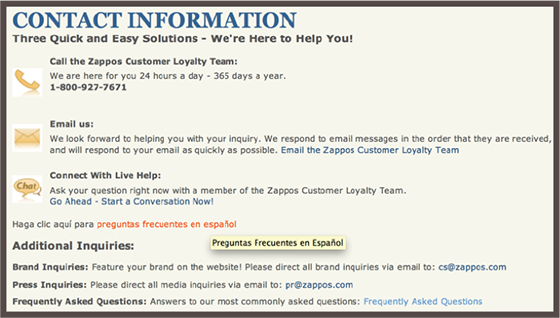
Most companies treat call centers as a cost. Zappos treats support as a brand stage. Reps aren’t chained to rigid scripts—they’re encouraged to be present, listen deeply, and let their personalities shine.
That’s why Zappos is known for sending flowers, surprising customers with overnight shipping upgrades, and staying on the phone for hours when someone needs it.
“Sometimes people just need to call and talk,” said Shaea Labus, the employee who stayed on a call for almost 10 hours. “We don’t judge, we just want to help.”
Make customers genuinely happy and you earn loyalty that competitors can’t easily disrupt.
Engaging the Senses
Online marketing is visual-first, but you aren’t limited to a flat, two-dimensional experience. The more senses you evoke, the easier it is for people to imagine your product in their lives.
Invite customers to picture an experience with your product. Use sound with explainers, demos, or webinars. Use motion to show outcomes. Use interactivity to reduce uncertainty and drive confidence.
When Spotify launched in the U.S., it paired simple visuals with a memorable soundtrack to communicate value in seconds—no complex production required.

Coastal, an ecommerce retailer for contacts and glasses, uses a “try-it-on” feature so shoppers can see how frames look on their own faces—bridging the gap between screen and reality.

Brand Personality
We use “personality” to describe people we know—friends, coworkers, family. It’s the mix of qualities that makes someone distinct.
Personalities live in the eye of the beholder. We love some, we dislike others. Brands are no different.
It can feel odd to say a brand has a personality, yet we talk about it constantly because customers feel it constantly.
What Is a Brand Personality?
A brand personality is the set of attributes that give an organization a distinct character. Some brands have striking, unmistakable personalities; others feel generic. Strong personalities cluster around a tight set of traits customers can name.
Great personalities don’t happen by accident. They’re designed, documented, and reinforced.
Moosejaw is a solid example. This outdoor retailer is playful, experimental, adventurous, and self-aware. The team tests fun branding ideas (mystery gifts, freebies) and even pokes light fun at legalese. Their return policy reads like a “living will”—memorable and on-brand.
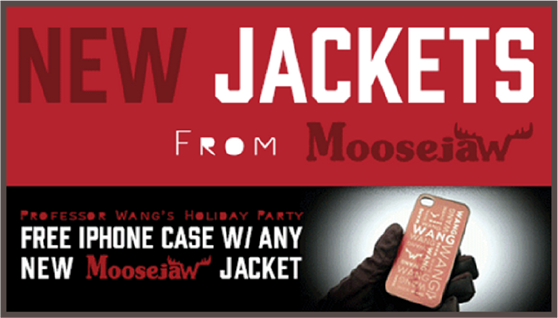
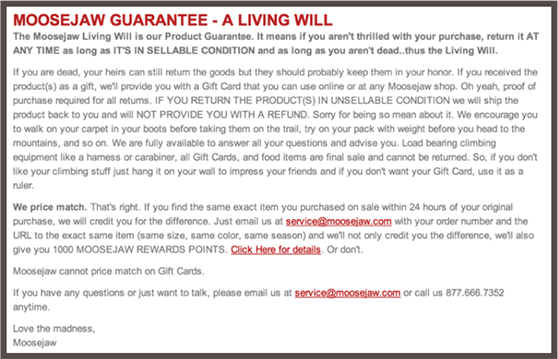
Where Do Brand Personalities Come From?
Leadership can define any personality—fun-loving, serious, professional, or a unique blend.
What matters most is defining it clearly and early. The process should include the whole team—not just a handful of managers.
Why? Because the people closest to the work bring your personality to life. Product, partnerships, service, and support all reflect the identity you set.
Consider KISSmetrics. The brand leans analytical, educational, helpful, direct, metrics-driven, and proudly nerdy. Those traits show up everywhere—from the homepage to blog posts packed with tips, how-tos, and best practices.
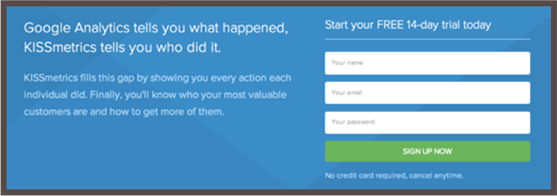
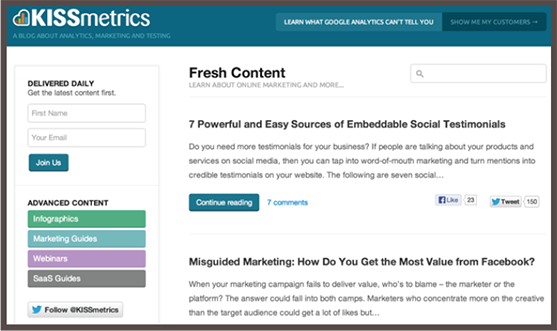
Who Is Responsible for Your Company’s Brand Identity?
The short answer? Everyone.
Your brand personality should show up in marketing copy, social posts, customer emails, sales decks, and product microcopy. Executives, managers, and entry-level teammates should be able to state—and embody—your brand traits.
Your people are your brand. Hire, train, and partner with folks who live your core values. Shared values make consistent execution easier.
Culture, marketing, and design work best together. To align them, start with a clear, top-down strategy and reinforce it daily.
How Do You Define Your Company’s Brand Identity?
Brand identity won’t materialize out of thin air. It takes deliberate planning. You’ll likely need a cross-functional team, and a consultant can help if you have the budget. This asset unifies product, marketing, design, and customer communication—so it’s worth the rigor.
Use these steps to get started:
- List keywords that describe your current brand image. Invite the entire team. Use a whiteboard, shared doc, or spreadsheet—whatever helps ideas flow.
- List keywords that describe how you want your brand to be perceived. Involve the team again. Compare lists to reveal gaps between “is” and “want.”
- Trim to 2–3 core phrases. It’s hard, but necessary. Real people need to recall and apply these traits quickly; dozens of words won’t stick.
- Create a message architecture—a prioritized hierarchy of communication goals that define your brand’s highest-impact attributes. Use shared, concrete terminology. Pick the format that suits your organization, but make it organized and clear.
- Create a style guide. Translate principles into practical rules for voice, tone, word choice, and examples. Keep it concise so teams actually use it.
Here’s an example of a simple brand style guide:
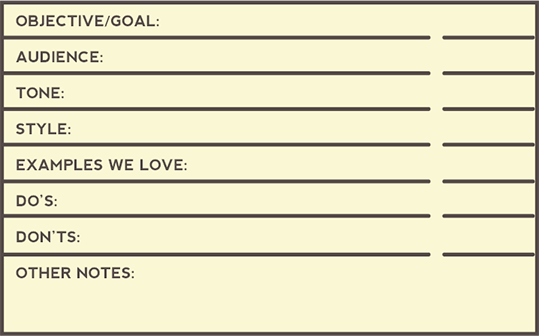
The simpler the guidance, the less friction teams face—and the more consistent your marketing becomes.
Avoiding Cheesiness
Emotions can go from effective to cringe fast. One moment you’re building rapport; the next, your message feels over the top and audiences tune out—or mock it.
How do you avoid that?
- Make honesty the default. Encourage blunt internal feedback so weak ideas get fixed (or cut) early.
- Gather diverse feedback. Don’t rely on a single cohort. Ask Gen X, Millennials, and Gen Z to weigh in—tone lands differently by generation.
- Face-test with trusted customers. Use a small “sounding board” who will tell you the truth without sugarcoating.
- Design for audience needs. Some groups tolerate sentimental messaging; others prefer dry, direct communication. Match tone to context.
Because “cheesy” is subjective, the safest path is empathy: build messages from your audience’s point of view.
Creating Viral Campaigns
Some brands make virality look effortless. Dollar Shave Club famously used a hilarious video to acquire customers—seemingly overnight.
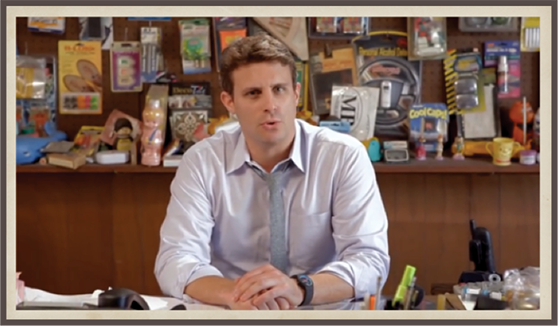
Behind the scenes, successful “viral” ideas follow patterns. You can’t guarantee breakout reach, but you can raise the odds by hitting the right emotions.
In a Harvard Business Review article, Kelsey Libert and Kristin Tynski outline how to improve your chances:
- Make people care (so they share). Lead with a powerful story, not a hard sell. Heavy branding signals “ad” and triggers quick dismissal. Don’t manipulate—respect your audience’s intelligence and needs.
- Map the emotions common in viral content. Their research found positive emotions dominate, while negative emotions can still work when paired with anticipation or surprise. Common emotions: curiosity, amazement, interest, astonishment, uncertainty, admiration.
- Connect your brand to the emotion without hijacking the message. Choose topics that naturally underscore your positioning and value.
- Favor ideas that contribute to the public good. When content helps people, they’re more inclined to share it widely.
Think bigger than your brand. Create genuine value and the audience will do the distribution.
The Unspoken Power of Delight
Delight can outperform any tagline. It’s the joy of watching a toddler navigate a smartphone, the lift you feel walking into a favorite boutique after a tough day, or the surprise of a free shipping upgrade when you needed it most.
Some leaders write delight off as “fluff.” It isn’t. While not every variable is measurable, delight correlates with repeat purchase, referrals, and lifetime value. Obsess less over proving every micro-metric and more over designing experiences customers rave about.
Delight doesn’t happen by accident. It’s designed into core functions:
- Product
- Marketing
- Account management/client services
- Aesthetics
Delight often evokes these emotions:
- Humor
- Inspiration
- Admiration
- Awe
- Surprise
Because “delight” sounds nebulous, you’ll need a concrete plan. Here’s how to make it real:
- Evaluate customer pain points. Study on- and off-site behavior, interview customers, and map journeys to surface moments that matter. Build personas from real insights.
- Define your brand promise. Distill the research into a one-to-two-sentence statement that sets expectations you can keep.
- Brainstorm specific actions that deliver that promise—features, policies, moments of surprise—and prioritize those with the highest customer impact.
Measure branding and delight at the macro level with trend metrics:
- Repeat Customers: Track the share of customers who return and how often.
- Word-of-Mouth: Use social shares and recommendations as proxies for advocacy.
- Average Order Value: Watch whether customers spend more over time.
- Lifetime Value: Monitor long-term revenue per customer as brand affinity grows.
- Market Share: Compare against top competitors to see if loyalty is translating into growth.
Delight pairs naturally with personality: delight is customer-centric; personality is brand-centric. Together, they make experiences people remember.
Staying Ethical
There’s a line between courting and manipulating customers. Emotions make people vulnerable, so handle them with care. Walk that line thoughtfully and treat people with respect.
Fear is a powerful—often abused—emotion.
Sometimes fear is appropriate, especially in matters of health and safety. This CDC ad, for example, aims to deter smoking by confronting a real threat:

The factor that most influences whether people act to avoid a threat is efficacy—the belief they can do something about it.
Yes, marketers can scare customers into buying. Should they? Not if fear is exaggerated or deceptive. If you’re communicating truthful risks and helping people avoid real problems, fear can be used responsibly.
Give your message a value test. Are you adding value to the world—or extracting it? If it’s the latter, change course.
Logitech provides a balanced example with a home video security ad that echoes questions parents already ask. By normalizing the concern and offering a solution, the message reassures rather than exploits.
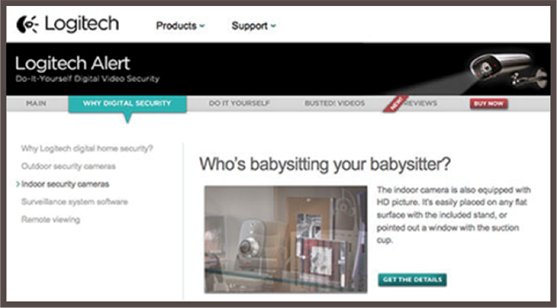
They also ran a “busted” campaign showing credible real-world risks. It’s unsettling—but grounded—so prospects can make informed choices.
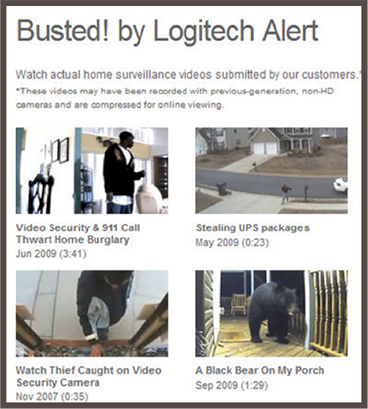
Here’s an ad that crosses the line: “If you aren’t totally clean, you are filthy.”

It’s questionable because it’s unreasonable. Yes, hands have germs—but implying people are covered in cockroaches (and letting them crawl on children) is sensational and inaccurate.
Many people have insect phobias; this kind of imagery can be needlessly distressing.
Emotional marketing touches vulnerabilities. Tread carefully—you don’t always know who you might alienate or anger.
Build Emotions Into Your Brand Community
Social media gives customers space to share what they think and feel—about your brand and beyond. Keep the dialogue open to encourage word-of-mouth. Problems arise when people vent about negative experiences.
Many companies default to deleting comments or moving conversations behind closed doors.
Don’t do that.
If an issue pops up, show there’s a real person behind the logo. Apologize, fix what you can, and offer a fair solution. Don’t fear public threads—be authentic, empathetic, and calm, even when emotions run hot.
FedEx modeled this well when a video of a careless package delivery driver went viral on YouTube. The company released an official video statement that essentially said, “We’re sorry. We’re addressing it,” and explained next steps.
Own mistakes, then demonstrate care through action.
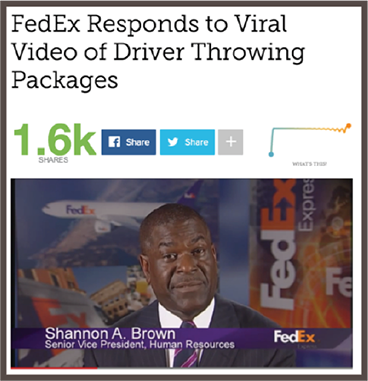
Key Takeaways
- People buy based on feelings first, then justify with facts.
- Use emotion to connect human-to-human across your journey—not just at the point of sale.
- Not everything emotional is easily quantified. If you only chase what’s measurable, you risk missing relationship-building opportunities.
- Define brand personality from the top down and document it. Tools like message architectures and style guides keep teams aligned.
- Culture powers brand. Hire and develop people who embody your values so execution is consistent in support, sales, product, and marketing.
- Track delight and loyalty with macro metrics: lifetime value, average order value, repeat purchase rate, share of voice, and market share.
- Emotions make audiences vulnerable. Be respectful. Avoid manipulative fear tactics and ground your messages in truth and efficacy.
- Social channels are public forums for feelings. Don’t suppress criticism—solve problems transparently and build trust in the open.
